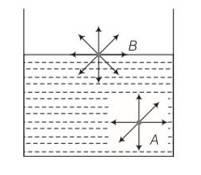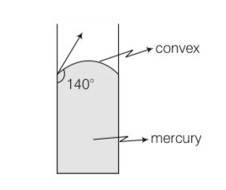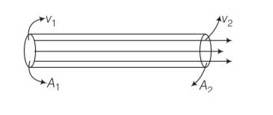physics ncert solutions class 11th
Get insights from 952 questions on physics ncert solutions class 11th, answered by students, alumni, and experts. You may also ask and answer any question you like about physics ncert solutions class 11th
Follow Ask QuestionQuestions
Discussions
Active Users
Followers
New answer posted
4 months agoContributor-Level 10
This is a multiple choice answer as classified in NCERT Exemplar
(b), (c) Pressure is defined as the ratio of magnitude of component of the force normal to the area and the area under consideration.
As magnitude of component is considered, hence, it will not have any direction. So, Pressure is a scalar quantity.
New answer posted
4 months agoContributor-Level 10
This is a multiple choice answer as classified in NCERT Exemplar
(b), (d) Consider the diagram where two molecules of a liquid are shown. One is well inside the liquid and other is on the surface. The molecule (A) which is well inside experiences equal forces from all directions, hence net force on it will be zero.
And molecules on the liquid surface have some extra energy as it surrounded by Only lower half side of liquid molecules.

New answer posted
4 months agoContributor-Level 10
This is a multiple choice answer as classified in NCERT Exemplar
(c) According to the question, the observed meniscus is of convex figure shape. Which is only possible when angle of contact is obtuse. Hence, the combination will be of mercury-glass (140°)

New answer posted
4 months agoContributor-Level 10
This is a multiple choice answer as classified in NCERT Exemplar
(a) d1= diameter at 1st point is 2.5

d2= diameter at 2nd point is 3.75
Applying equation of continuity for cross section A1 and A2
A1V1=A2V2
2
= =
New answer posted
4 months agoContributor-Level 10
This is a multiple choice answer as classified in NCERT Exemplar
(b) As we know for a streamline flow of a liquid velocity of each particle at a particular cross-section is constant, because Av = constant (law of continuity) between two cross-section of a tube of flow.
New question posted
4 months agoNew answer posted
4 months agoContributor-Level 10
This is a multiple choice answer as classified in NCERT Exemplar
(d) In a streamline flow at any given point, the velocity of each passing fluid particles remains constant. If we consider a cross-sectional area, then a point on the area cannot have different velocities at the same time, hence two streamlines of flow cannot cross each other.
New answer posted
4 months agoContributor-Level 10
This is a multiple choice answer as classified in NCERT Exemplar
(c) When the pebble is falling through the viscous oil the viscous force is
F=6
where r is radius of the pebble, v is instantaneous speed, his coefficient of viscosity. As the force is variable, hence acceleration is also variable so v-t graph will not be straight line. First velocity increases and then becomes constant known as terminal velocity.
New answer posted
4 months agoContributor-Level 10
This is a short answer type question as classified in NCERT Exemplar
Surface tension of water S= 7.28*10-2 Nm-1
Vapour pressure p= 2.33*103 Pa
The drop will evaporate, if the water pressure is greater than the vapour pressure.
Let a water droplet or radius R can be formed without evaporating.
Vapour pressure= Excess pressure in drop.
P=2S/R
R= 2S/P=
New answer posted
4 months agoContributor-Level 10
This is a short answer type question as classified in NCERT Exemplar
When a big drop of radius R, breaks into N droplets each of radius r, the volume remains constant.
Volume of big drop = N volume of each small drop
R3 =Nr3
N=R3/r3
Now change in surface area = 4 -N4 r2
= 4
Energy released = T = S
Due to releasing of this energy , the temperature is lowered.
If is the density and s is specific heat of liquid and its temperature is lowered by , then energy released = ms
T ( )=
=
=
=
Taking an Exam? Selecting a College?
Get authentic answers from experts, students and alumni that you won't find anywhere else
Sign Up on ShikshaOn Shiksha, get access to
- 65k Colleges
- 1.2k Exams
- 686k Reviews
- 1800k Answers


